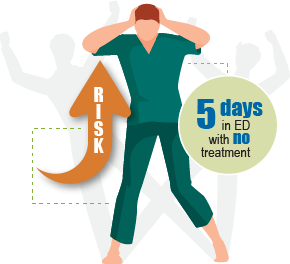 Recent studies demonstrate that about 10% of all emergency department patients present with psychiatric illness. Because of the unique risks associated with psychiatric patients, coordinating their care and admission has proven to be a challenge for emergency physicians. Here we present a case that highlights the risks of boarding patients in the emergency department.
Recent studies demonstrate that about 10% of all emergency department patients present with psychiatric illness. Because of the unique risks associated with psychiatric patients, coordinating their care and admission has proven to be a challenge for emergency physicians. Here we present a case that highlights the risks of boarding patients in the emergency department.
Case Presentation
A 37-year-old chronic schizophrenic male patient was brought to the ED by police because he was directing traffic without any clothes on. The patient is homeless and is known to the staff for non-compliance with his medication. He has a history of hypertension and drinks alcohol.
The physical exam reveals a blood pressure of 162/94, pulse of 96, respiratory rate of 20 and normal temperature. The heart, lung and abdomen exams are normal. The physician orders screening lab tests and contacts the outside community mental health service to perform the psychiatric evaluation.
 The outside psychiatric service evaluates the patient and recommends admission. The emergency service concurs. Since the patient has no funding, the patient is to be transferred to the state psychiatric hospital. The state facility is full, cannot accept the patient at this time, and requests additional laboratory tests. They request to be contacted again the next day. Even though the hospital has an inpatient psychiatric unit and available beds on that unit, it is an unwritten policy of the hospital not to admit unfunded patients to this unit.
The outside psychiatric service evaluates the patient and recommends admission. The emergency service concurs. Since the patient has no funding, the patient is to be transferred to the state psychiatric hospital. The state facility is full, cannot accept the patient at this time, and requests additional laboratory tests. They request to be contacted again the next day. Even though the hospital has an inpatient psychiatric unit and available beds on that unit, it is an unwritten policy of the hospital not to admit unfunded patients to this unit.
Since the patient is not actively suicidal and the ED is already overwhelmed with psychiatric patients, the staff places the patient in a hallway of the mental health area in the ED and administers haloperidol for his agitation. The patient thinks the male nurse is the devil and strikes him in the face, inflicting a nasal bone fracture. The nurse later goes on to develop PTSD and files a workers compensation claim against the hospital.
The patient is sedated and falls asleep in the ED. Occasionally he awakens and screams at the nursing staff, who respond with an additional dose of haloperidol.
The ED contacts the state facility again the next day. They are full but think they will have a bed in another day or two. The emergency staff keeps the patient sedated and feeds him but does little else. The sign-out from ED physician to physician states that the patient is waiting for a state hospital bed. After 5 days of boarding in the ED, the state psychiatric hospital accepts the patient in transfer.
Risk Concerns
Inadequate treatment
 The patient spent five days in the emergency department with little or no treatment. In these frequent instances of ED boarding, the risk of iatrogenic and symptom escalation due to non-treatment is high. These patients can have worsening of their psychosis, depression or mania while waiting for a bed. It is rare that a chest pain, trauma or stroke patient would go untreated in the ED, but for some reason emergency physicians are reluctant to treat psychiatric patients. In cases of medication non-compliance, it is appropriate and well within the standard of care to restart the patient’s psychotropic medication while they wait in the ED for admission or transfer. The risk of medications used to treat cardiac or stroke patients has a significant risk profile, including death, as compared to psychotropic medications. The major risk of providing a patients their psychiatric medication is an inadvertent overdose or medication side effects. The risk of overdose is highly unlikely in this environment and the concern about medication side effect is minimal, since the patient had been on the medication on a long-term basis. If the emergency physician is uncomfortable prescribing these medications, a psychiatrist can be contacted either from the consultation liaison service or even via telepsychiatry.
The patient spent five days in the emergency department with little or no treatment. In these frequent instances of ED boarding, the risk of iatrogenic and symptom escalation due to non-treatment is high. These patients can have worsening of their psychosis, depression or mania while waiting for a bed. It is rare that a chest pain, trauma or stroke patient would go untreated in the ED, but for some reason emergency physicians are reluctant to treat psychiatric patients. In cases of medication non-compliance, it is appropriate and well within the standard of care to restart the patient’s psychotropic medication while they wait in the ED for admission or transfer. The risk of medications used to treat cardiac or stroke patients has a significant risk profile, including death, as compared to psychotropic medications. The major risk of providing a patients their psychiatric medication is an inadvertent overdose or medication side effects. The risk of overdose is highly unlikely in this environment and the concern about medication side effect is minimal, since the patient had been on the medication on a long-term basis. If the emergency physician is uncomfortable prescribing these medications, a psychiatrist can be contacted either from the consultation liaison service or even via telepsychiatry.
Boarding psychiatric patients in the ED
As this case illustrates, boarding of psychiatry patients in the ED while they await an inpatient bed somewhere else is risky, both for the patient and staff. There are many options to decrease boarding and reduce the cost of services for these patients. Providing treatment early in their ED visit may result in effective stabilization and reduce the need for admission. These patients can also be referred to other, perhaps more appropriate, resources in the community. Other options to reduce the influx of patients to the ED include referring patients to such services as mobile crisis care, crisis phone services, walk-in psychiatric clinics and living room models of care.
![]() Possibly because emergency physicians are uncomfortable assessing and discharging them, psychiatric patients are admitted to the hospital at twice the rate of medical patients. Although not as sophisticated as criteria for admission for medical patients, there are some clinical decision models that can assist in determining the need for psychiatric admission. This is also true for suicidal patients, where low-risk suicide patients may go home. The use of psychiatric observation or crisis stabilization units has dramatically reduced the number of psychiatric patients who require admission. Similar to medical observation, the patient’s evaluation and treatment may begin in the ED and be completed in psychiatric observation in 23 hours or less.
Possibly because emergency physicians are uncomfortable assessing and discharging them, psychiatric patients are admitted to the hospital at twice the rate of medical patients. Although not as sophisticated as criteria for admission for medical patients, there are some clinical decision models that can assist in determining the need for psychiatric admission. This is also true for suicidal patients, where low-risk suicide patients may go home. The use of psychiatric observation or crisis stabilization units has dramatically reduced the number of psychiatric patients who require admission. Similar to medical observation, the patient’s evaluation and treatment may begin in the ED and be completed in psychiatric observation in 23 hours or less.
EMTALA Marshall suites isolation
A recent EMTALA investigation in South Carolina found that a hospital cannot hold psychiatric patients in its ED while waiting for an inpatient bed in a state facility when beds are available in its own institution. State policies, customs or practices do not trump the federal mandate.
The federal government fined ANMed $1.2 million for this EMTALA violation of boarding psychiatric patients in its ED for days. The hospital held 36 psychiatric patients in its ED without appropriate treatment. Instead of admitting patients to its hospital, the patients stayed anywhere from 6 to 38 days in the ED. During this time, there was no evaluation by psychiatry. The hospital contended that it could admit involuntarily committed patients because their unit only accepted voluntary patients. It was hospital policy to transfer all involuntary patients to the state hospital. This was thought to be the equivalent of sending unfunded patients to the state hospital. In its plan to correct the EMTALA violation, the hospital changed its policy to accept involuntary patients and added 19 beds to its inpatient unit.
Unsafe work environment
 Psychiatric patients are at high risk for violence towards staff, other patients, and visitors. Psychiatry patients and their clothing must be properly searched prior to placement in a room, not only for weapons, but also for contraband that could be used to harm themselves. It is recommended that all psychiatric patients have their clothes removed and that they be placed in a gown. Most institutions give the patient a specific gown color or ID band that signifies they are a psychiatric patient and should not be allowed to elope. The routine use of restraints, seclusion and sedation to prevent elopement is not an acceptable reason to perform these interventions.
Psychiatric patients are at high risk for violence towards staff, other patients, and visitors. Psychiatry patients and their clothing must be properly searched prior to placement in a room, not only for weapons, but also for contraband that could be used to harm themselves. It is recommended that all psychiatric patients have their clothes removed and that they be placed in a gown. Most institutions give the patient a specific gown color or ID band that signifies they are a psychiatric patient and should not be allowed to elope. The routine use of restraints, seclusion and sedation to prevent elopement is not an acceptable reason to perform these interventions.
Psychiatric patients are also at risk for completing suicide or performing self-harm while in the ED and must be properly monitored to prevent these acts. Psychiatric areas in the ED must conform to all the standards of safety found on the psychiatric floor.
This case illustrates risk issues in caring for psychiatric patients in the emergency department. The physical area is usually ill-equipped and the staff are reluctant to care for these patients. The care environment, staffing, and treatment protocols and processes need to be enhanced to reduce the risks associated with psychiatric patients in the emergency department.


